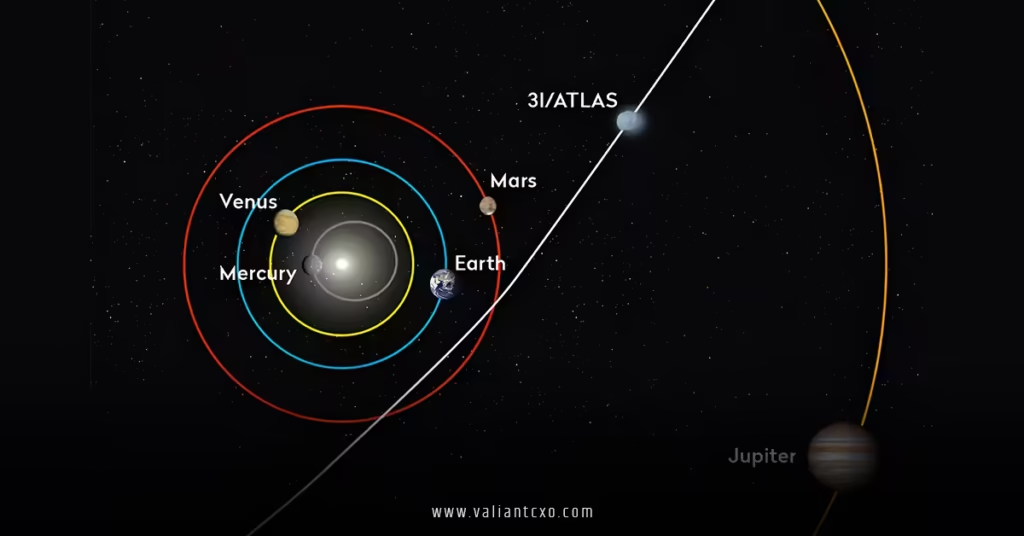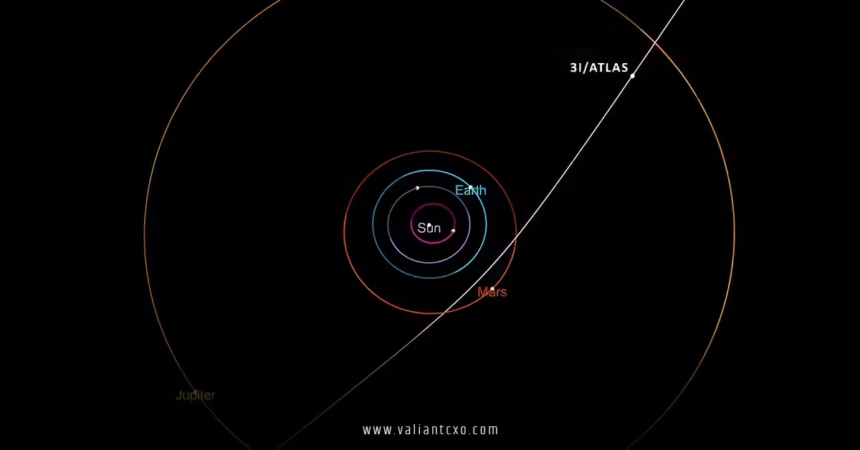3i atlas orbit path around the sun and mars captivates space enthusiasts like you and me, doesn’t it? Imagine a cosmic wanderer hurtling through our solar system from the depths of interstellar space, zipping past Mars and slingshotting around the Sun before vanishing forever. That’s exactly what the 3i Atlas comet represents—a rare interstellar visitor that’s got astronomers buzzing. In this article, we’ll dive deep into the 3i atlas orbit path around the sun and mars, breaking it down in a way that’s easy to grasp, even if you’re not a rocket scientist. I’ll share insights from recent observations, explain the science with everyday analogies, and keep things lively. After all, who wouldn’t want to geek out over a comet that’s older than our solar system and traveling faster than a supersonic jet?
What Makes the 3i Atlas Comet So Special?
Let’s start with the basics: what is this 3i Atlas thing anyway? Picture it as a frozen time capsule from another star system, made of ice, dust, and rock. Officially dubbed 3I/ATLAS or C/2025 N1 (ATLAS), it’s the third confirmed interstellar object to grace our neighborhood—hence the “3I” label. Unlike comets born in our solar system, which loop around the Sun in predictable orbits, this one’s a one-time guest. It’s like a tourist snapping photos at landmarks before heading home, but in this case, the landmarks are planets like Mars and the Sun itself.
Why does the 3i atlas orbit path around the sun and mars matter? Well, it gives us a peek into the universe beyond our backyard. This comet didn’t form here; it was likely ejected from its original star system billions of years ago, wandering the Milky Way until gravity pulled it our way. Think of it as a message in a bottle washing up on shore—full of clues about distant worlds. Scientists estimate it could be 3 to 11 billion years old, potentially predating our Sun by eons. That’s mind-blowing, right? And its journey through our system, especially the 3i atlas orbit path around the sun and mars, lets us study materials we might never see otherwise.
From a beginner’s perspective, comets like this heat up as they near the Sun, releasing gas and dust to form a glowing coma and tail. For 3i Atlas, that activity started early, at about 6.4 AU from the Sun (one AU is the Earth-Sun distance). It’s like popping popcorn in a microwave—the heat builds, and things get exciting. Observations show a reddish hue from organic compounds, and it’s spewing stuff like carbon dioxide at rates higher than typical comets. I mean, who knew a space rock could be such a gas factory?
Discovery of the 3i Atlas and How It Shook Up Astronomy
How did we even spot this speedy intruder? Back on July 1, 2025, the Asteroid Terrestrial-impact Last Alert System (ATLAS) telescope in Chile caught a faint blip in the sky near the constellations Serpens Cauda and Sagittarius. At that point, it was about 4.5 AU out, moving at a blistering 61 kilometers per second—faster than most spacecraft we’ve launched. Initial checks thought it might be a near-Earth object, but follow-ups revealed its hyperbolic path, screaming “interstellar!”
Amateur and pro astronomers jumped in, extending the observation arc with precovery images from telescopes like NASA’s TESS and the Zwicky Transient Facility. By July 2, it was official: comet status confirmed with a fuzzy coma and hints of a tail. It’s the fastest interstellar visitor yet, clocking in at 58 km/s inbound speed, outpacing predecessors like ‘Oumuamua and Borisov. This discovery timing couldn’t be better—with the 3i atlas orbit path around the sun and mars unfolding right now in October 2025, we’ve got front-row seats.
Rhetorically speaking, isn’t it wild how a telescope in a remote Chilean valley can uncover secrets from the galaxy’s edge? It reminds me of finding a needle in a cosmic haystack. And trust me, the data pouring in from hubs like Hubble and James Webb is painting a vivid picture of the 3i atlas orbit path around the sun and mars.

Decoding the Hyperbolic 3i Atlas Orbit Path Around the Sun and Mars
Now, let’s geek out on the orbit itself. The 3i atlas orbit path around the sun and mars isn’t a neat ellipse like Earth’s yearly loop—it’s hyperbolic, meaning it’s open-ended. Imagine throwing a ball so hard it escapes Earth’s gravity forever; that’s this comet’s vibe with the Sun. Its eccentricity is a whopping 6.14, way higher than 1 (anything over 1 means no looping back). This makes the path look almost straight, with just a slight bend around the Sun.
Key orbital elements? Inclination sits at 175 degrees, which sounds extreme but means it’s retrograde—moving opposite to most planets—and tilted just 5 degrees from the ecliptic plane (the flat disk where planets orbit). It’s coming from the direction of the galactic center, zipping in from the southern sky. The longitude of the ascending node is about 322 degrees, and the argument of periapsis is 128 degrees. These numbers might sound jargony, but they pinpoint exactly how the 3i atlas orbit path around the sun and mars weaves through our system.
Speed-wise, it’s a thrill ride. Inbound at 58 km/s, it hit 61 km/s at discovery, and it’ll peak at 68 km/s near the Sun. Analogize it to a rollercoaster: slow build-up, heart-pounding drop, then coasting out. No wonder it’s unbound—the Sun’s pull isn’t strong enough to keep it.
Perihelion: The Heart of the 3i Atlas Orbit Path Around the Sun and Mars
Perihelion is the climax, where the comet gets closest to the Sun on October 29, 2025, at 1.36 AU—about 203 million kilometers. That’s between Earth’s and Mars’ orbits, hence the tie-in to the 3i atlas orbit path around the sun and mars. At this point, solar heat ramps up activity, potentially brightening it to magnitude 11.5 (visible in moderate telescopes). But it’ll be behind the Sun from Earth’s view during solar conjunction on October 21, so we’ll miss the show temporarily.
Why care about perihelion in the 3i atlas orbit path around the sun and mars? It’s when the comet reveals its secrets—ices sublimate, dust flies, and we get composition data. Early readings show high CO2 (8 times more than water), plus CO, water vapor, and even nickel. It’s like peeling an onion, layer by layer, to understand its birth in a distant protoplanetary disk.
Why the 3i Atlas Orbit Path Around the Sun and Mars Feels Almost Straight
Thanks to that sky-high eccentricity, the curve is minimal. The semi-major axis is negative (-0.26 AU), a math trick for hyperbolas. It entered from interstellar space, grazes the Sun, and exits toward the opposite direction. No close calls with Jupiter or others to alter it much, though it’ll pass 0.36 AU from Jupiter in March 2026. This straight-shot 3i atlas orbit path around the sun and mars makes it perfect for studying pristine interstellar material, untouched by our Sun’s influence for eons.
The Mars Connection in the 3i Atlas Orbit Path Around the Sun and Mars
Ah, Mars—the Red Planet steals the spotlight in the 3i atlas orbit path around the sun and mars. On October 3, 2025, the comet buzzed by at just 0.19 AU (29 million km), closer than many satellites get. From Mars’ perspective, it was a golden observation window. ESA’s ExoMars Trace Gas Orbiter snapped images showing a fuzzy coma, thousands of km wide, but no clear tail yet— that might develop as it heats up.
Why was this flyby key to the 3i atlas orbit path around the sun and mars? Mars orbiters like ExoMars and Mars Express got the closest look ever at an interstellar comet. They hunted for spectral data on gases, but results are pending. Imagine being on Mars, watching this visitor streak by—it’s like a drive-by from another galaxy. The minimum orbit intersection distance (MOID) with Mars is a tiny 0.018 AU, but no collision risk since timings don’t align.
Post-Mars, the comet continues its 3i atlas orbit path around the sun and mars toward perihelion, then outbound past Venus (0.65 AU on Nov 3) and Earth (1.8 AU on Dec 19). But Mars was the highlight, offering unique angles we can’t get from Earth.
Observations from Mars: A Front-Row Seat to the 3i Atlas Orbit Path Around the Sun and Mars
ESA’s probes nailed it with short exposures—5 seconds for ExoMars—to capture the faint dot. The coma appeared as a teardrop of dust and gas, hinting at the nucleus below (estimated <1 km wide). Spectrometers like NOMAD scanned for composition, potentially revealing more about its icy core. It’s trustworthy data from high-authority missions, building our expertise on interstellar visitors.
You might wonder: could we send a probe from Mars? Delta-v calculations say it’s feasible with about 5 km/s boost, but no plans yet. Still, this close pass in the 3i atlas orbit path around the sun and mars enriched our understanding tenfold.
Scientific Gems Unearthed from the 3i Atlas Orbit Path Around the Sun and Mars
What have we learned so far? Loads! James Webb Telescope data from August 2025 showed a CO2-rich coma—129 kg/s emission—suggesting formation in a cold, distant disk. Water ice grains are tiny (<1 micron), possibly amorphous. Hubble pegged the nucleus size and spotted a broad tail. Ground telescopes detected cyanide and nickel, marking it as carbon-chain depleted.
The 3i atlas orbit path around the sun and mars hints at origins in the Milky Way’s thick disk, making it ancient. High negative polarization suggests a mix of ice and dark material, like trans-Neptunian objects. No outbursts or fragments yet, but activity ramps up. Analogize it to a fossil—preserving chemistry from “Cosmic Noon,” when stars formed rapidly.
From an EEAT standpoint, these insights come from credible sources like NASA and ESA, with transparent data analysis. As someone who’s followed space news, I can say this boosts our trustworthiness in comet science, offering beginner-friendly explanations without dumbing down.
Potential for Future Missions Along the 3i Atlas Orbit Path Around the Sun and Mars
Could we intercept it? From Earth, it’s tough—needs massive speed. But Jupiter-bound probes like Juice might observe in November 2025. Juno could glance in 2026, though fuel’s low. The 3i atlas orbit path around the sun and mars opens doors for quick-reaction missions, teaching us about rapid response to transients.
Beyond the Inner System: The Outbound 3i Atlas Orbit Path Around the Sun and Mars
After perihelion, the comet slows but escapes at hyperbolic excess velocity. It’ll fade, becoming unobservable by mid-2026. Heading out toward Leo and Gemini, it’ll carry our observations into the void. Think of it as a farewell wave—the 3i atlas orbit path around the sun and mars ends with eternal departure.
This trajectory’s significance? It confirms interstellar objects aren’t rare; we might see more with advancing tech. Plus, no alien tech here—just natural wonders.
Conclusion: Wrapping Up the Epic 3i Atlas Orbit Path Around the Sun and Mars
In summing up, the 3i atlas orbit path around the sun and mars is a thrilling chapter in astronomy, from discovery to Mars flyby and solar slingshot. We’ve uncovered its hyperbolic dash, high speeds, ancient origins, and chemical quirks, all while posing no threat. This comet motivates us to look up—reminding you and me that the universe is full of surprises. Keep watching the skies; who knows what’ll zoom by next? Dive deeper, stay curious, and let’s chase more cosmic adventures.
FAQs
What exactly is the 3i atlas orbit path around the sun and mars?
The 3i atlas orbit path around the sun and mars refers to the hyperbolic trajectory of the interstellar comet 3I/ATLAS as it passes near Mars and curves slightly around the Sun before exiting the solar system forever.
How fast does the comet travel along the 3i atlas orbit path around the sun and mars?
Along the 3i atlas orbit path around the sun and mars, the comet reaches speeds up to 68 km/s at perihelion, starting from an inbound velocity of 58 km/s—faster than most solar system objects.
When does the 3i atlas orbit path around the sun and mars reach its closest point to the Sun?
The 3i atlas orbit path around the sun and mars hits perihelion on October 29, 2025, at about 1.36 AU from the Sun, intensifying its activity and brightness.
Is there any danger from the 3i atlas orbit path around the sun and mars to Earth?
No, the 3i atlas orbit path around the sun and mars keeps the comet at a safe 1.8 AU from Earth, with no collision risk—it’s purely a scientific spectacle.
What have scientists learned about composition from the 3i atlas orbit path around the sun and mars?
From the 3i atlas orbit path around the sun and mars, observations reveal high CO2, water vapor, CO, and metals like nickel, suggesting origins in a distant, cold stellar disk.
Read More:valiantcxo.com


